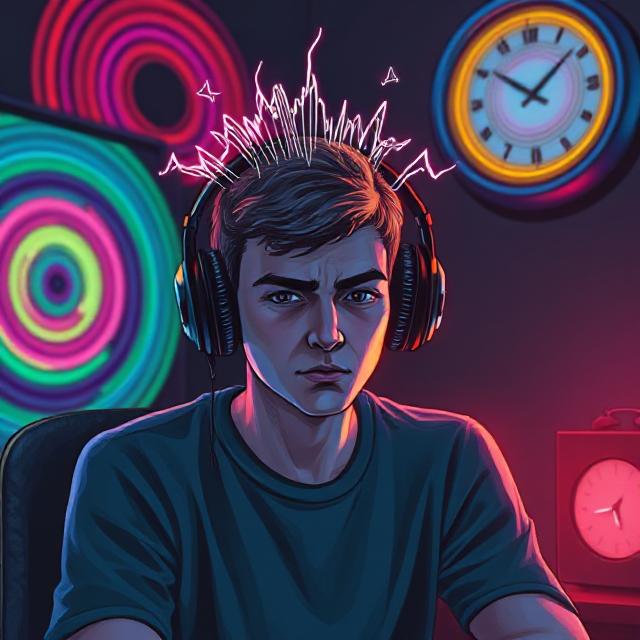
Table of Contents
Brainwave Entrainment Dangers: What to Avoid
Brainwave entrainment sounds like a shortcut to focus, creativity, or deep sleep. From binaural beats to isochronic tones and pulsed light, these tools promise to guide your brain into ideal mental states by mimicking natural brainwave rhythms.
And in many cases, they work.
But like any tool that affects your nervous system, entrainment carries risks if misused.
This guide breaks down the hidden dangers of brainwave entrainment—including the science behind overstimulation, the wrong frequency at the wrong time, and how to avoid the most common pitfalls. If you’re using audio, visual, or electromagnetic entrainment to enhance cognition or mood, read this before hitting play again.
⚠️ What Is Brainwave Entrainment?
Brainwave entrainment is the process of using rhythmic stimuli to guide the brain into specific frequency ranges. These external cues can be:
- Auditory (binaural beats, isochronic tones)
- Visual (flashing lights, photic stimulation)
- Electromagnetic (pulsed fields, neurostimulation devices)
Each type targets specific brainwave frequencies:
- Delta (0.5–4 Hz): deep sleep
- Theta (4–8 Hz): creativity, memory access
- Alpha (8–12 Hz): calm focus
- Beta (13–30 Hz): alertness, logical thinking
- Gamma (30–100+ Hz): insight, synthesis, cognition
The goal is to entrain your brain—syncing its natural rhythms to the external signal.
But that signal isn’t neutral. It affects neurochemistry, perception, and even emotional tone.
⚠️ 1. Overexposure Can Lead to Mental Exhaustion
One of the biggest dangers is assuming more is better.
People stack binaural sessions all day long hoping for a productivity surge—but instead, they feel:
- Brain fog
- Irritability
- Insomnia
- Anxiety-like symptoms
Why? Your brain isn’t meant to stay locked in one frequency for hours. For example:
- Too much alpha may dull cognition or lead to under-arousal.
- Excess beta can elevate stress hormones like cortisol.
- Overused theta may make you feel spacey or emotionally unstable.
Just as you wouldn’t work out the same muscle all day, your brain needs oscillatory balance.
⛔ Safe use tip: Limit sessions to 10–30 minutes max unless under professional guidance. Cycle different wave ranges across the week.
⚠️ 2. Wrong Frequencies at the Wrong Time
Using the wrong brainwave entrainment track for your current mental state can backfire.
Examples:
- Listening to high-beta entrainment when you’re already anxious = overstimulation
- Using theta tones while driving = drowsiness and slowed reaction
- Applying delta entrainment mid-day = brain fog and sluggishness
- Forcing gamma frequencies while fatigued = irritability or migraines
Your current brain state matters. Entrainment amplifies what’s already happening—so forcing a mismatch can destabilize your mood or cognition.
⛔ Safe use tip: Match entrainment to your desired but appropriate state. Avoid theta or delta when alertness is needed.
⚠️ 3. Photosensitive Seizures from Visual Stimulation
Photic stimulation (strobe-like lights or flashing visual patterns) can trigger seizures in some individuals—even if they have no known epilepsy history.
Frequencies between 10–30 Hz are particularly risky, especially when flashing at full-screen brightness.
Symptoms of overexposure include:
- Nausea
- Headaches
- Visual distortions
- Eye strain
- Dizziness or disorientation
⛔ Safe use tip: If using light-based entrainment, start at low brightness, avoid high-frequency flashes, and never use in a dark room without guidance.
⚠️ 4. Disrupted Sleep Cycles from Late-Night Use

Using stimulating frequencies—like beta or gamma—late at night can impair melatonin release and push your circadian rhythm out of sync.
Some users report:
- Trouble falling asleep after entrainment
- Restless dreams
- Shallow sleep or early waking
- Post-entrainment headaches
This is especially common when using entrainment without blue light filtering, or combining it with caffeine or intense focus sessions.
⛔ Safe use tip: Use only delta, theta, or gentle alpha frequencies in the 2–3 hours before bed. Skip all entrainment at least 60 minutes before sleep if sensitive.
⚠️ 5. False Dependency: When Entrainment Replaces Mental Training
One subtle risk is psychological dependence.
Users start to believe they can’t:
- Focus without beta tones
- Relax without alpha tracks
- Meditate without theta background audio
This can weaken your brain’s natural neuroplasticity and intrinsic control. Instead of training yourself to access states like calm or insight, you start relying on external crutches.
⛔ Safe use tip: Use entrainment as a supplement—not a replacement—for breathwork, meditation, journaling, and real cognitive training.
⚠️ 6. Unverified Devices and Dangerous Frequencies
Many DIY or cheap brainwave devices claim “neuro-enhancement” but use:
- Poorly researched frequency patterns
- Unsafe pulsing rates
- Unregulated EM fields
Some may actually induce harm—causing irritability, confusion, heart rate changes, or worsening mental health symptoms.
There are also anecdotal reports of:
- Induced tinnitus
- Prolonged “head pressure”
- Worsening of pre-existing conditions like anxiety or ADHD
⛔ Safe use tip: Vet the source of your tracks or devices. Avoid untested YouTube channels or suspicious downloads. Look for protocols backed by neuroscience or peer-reviewed study.
✅ Safe Brainwave Entrainment Practices
To stay safe, follow these core principles:
| Safety Principle | Description |
|---|---|
| Limit Duration | 10–30 minutes per session is ideal. |
| Avoid Overuse | Space sessions 6–8 hours apart. |
| Match State to Need | Don’t use beta if anxious, or theta if sleepy. |
| Start with Audio Only | Light-based systems carry more risk. |
| Check Contraindications | Especially if prone to seizures, migraines, or sleep disorders. |
| Combine with Lifestyle Tools | Use breathwork, cold exposure, movement, and natural light too. |
🧭 Final Reflection: Rhythm Is Medicine—If You Respect It
Brainwave entrainment is not a toy. It’s a powerful neural intervention.
Done right, it can support:
- Better focus
- Deeper sleep
- Emotional release
- Creative flow
But used carelessly, it can create imbalance, dependency, and distress.
Like any form of stimulation, timing, dose, and context matter.
Think of entrainment as training wheels—not the bike. Use it to awaken awareness—not bypass it.
